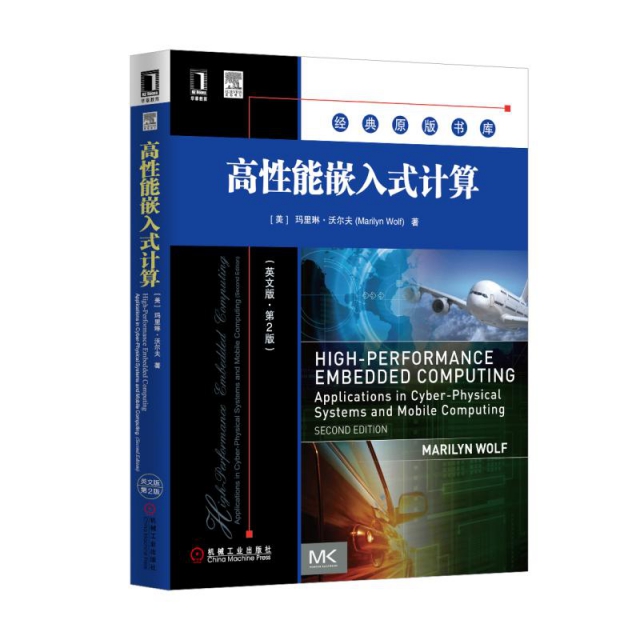| | | | 高性能嵌入式計算(英文版第2版)/經典原版書庫 | | 該商品所屬分類:計算機/網絡 -> 計算機原理 | | 【市場價】 | 715-1036元 | | 【優惠價】 | 447-648元 | | 【介質】 | book | | 【ISBN】 | 9787111499305 | | 【折扣說明】 | 一次購物滿999元台幣免運費+贈品
一次購物滿2000元台幣95折+免運費+贈品
一次購物滿3000元台幣92折+免運費+贈品
一次購物滿4000元台幣88折+免運費+贈品
| | 【本期贈品】 | ①優質無紡布環保袋,做工棒!②品牌簽字筆 ③品牌手帕紙巾
|
|
| 版本 | 正版全新電子版PDF檔 | | 您已选择: | 正版全新 | 溫馨提示:如果有多種選項,請先選擇再點擊加入購物車。*. 電子圖書價格是0.69折,例如了得網價格是100元,電子書pdf的價格則是69元。
*. 購買電子書不支持貨到付款,購買時選擇atm或者超商、PayPal付款。付款後1-24小時內通過郵件傳輸給您。
*. 如果收到的電子書不滿意,可以聯絡我們退款。謝謝。 | | | |
| | 內容介紹 | |

-
出版社:機械工業
-
ISBN:9787111499305
-
作者:(美)瑪裡琳·沃爾夫
-
頁數:484
-
出版日期:2015-05-01
-
印刷日期:2015-05-01
-
包裝:平裝
-
開本:16開
-
版次:1
-
印次:1
-
《高性能嵌入式計算(英文版第2版)》經過全面
更新和擴展,涵蓋了現代高性能嵌入式繫統設計領域
使用的廣泛技術。現在智能手機、飛機、汽車、電力
設備、醫療設備等許多應用都在使用嵌入式多處理器
,所以讓繫統設計人員理解這些復雜技術必須依賴越
來越復雜的硬件、軟件和設計方法是非常重要的。
瑪裡琳·沃爾夫教授采用一種獨特的量化方法來
論述現代嵌入式計算繫統的設計,解釋如何定義和實
現性能、功耗和成本的量化目標。貫穿全書的實際應
用使得本書對專業人員、研究人員和學生來說都是及
時且非常有價值的資源。
第2版主要特點:
包含全新的一章,討論信息物理繫統(CPS)——
將控制理論和嵌入式計算相結合的新興智能繫統。
討論嵌入式計算的高級主題。包括針對嵌入式繫
統的熱感知設計、可配置處理器、實時約束和功耗的
軟件優化、異構多處理器和嵌入式中間件。
深入討論網絡、可重配置繫統、軟硬件協同設計
、安全和程序分析。
-
Preface to the Second Edition
Preface to the First Edition
Acknowledgments
CHAPTER 1 Embedded Computing
1.1. The landscape of high-performance embedded computing
1.2. Cyber-physical systems and embedded computing
1.2.1. Vehicle control and operation
1.2.2. Medical devices and systems
1.2.3. Electric power
1.2.4. Radio and networking
1.2.5. Multimedia
1.3. Design methodologies
1.3.1. Why use design methodologies?
1.3.2. Design goals
1.3.3. Basic design methodologies
1.3.4. Embedded system design flows
1.3.5. Standards-based design methodologies
1.3.6. Design verification and validation
1.3.7. A methodology of methodologies
1.3.8. Joint algorithm and architecture development
1.4. Models of computation
1.4.1. Why study models of computation?
1.4.2. The Turing machine
1.4.3. Stream-oriented models
1.4.4. Representations of state and control
1.4.5. Parallelism and communication
1.4.6. Sources and uses of parallelism
1.5. Reliability. safety. and security
1.5.1. Why reliable embedded systems?
1.5.2. Fundamentals of reliable system design
1.5.3. Novel attacks and countermeasures
1.6. Consumer electronics architectures
1.6.1. Bluetooth
1.6.2. WiFi
1.6.3. Networked consumer devices
1.6.4. High-level services
1.7. Summary and a look ahead
What we learned
Further reading
Questions
Lab exercises
CHAPTER 2 CPUs
2.1. Introduction
2.2. Comping processors
2.2.1. Evaluating processors
2.2.2. ATaxonomy of processors
2.2.3. Embedded vs. general-purpose processors
2.3. RISC processors and digital signal processors
2.3.1. RISC processors
2.3.2. Digital signal processors
2.4. Parallel execution mechanisms
2.4.1. Very long instruction word processors
2.4.2. Superscalar processors
2.4.3. SIMD and vector processors
2.4.4. Thread-level parallelism
2.4.5. GPUs
2.4.6. Processor resource utilization
2.5. Variable-performance CPU architectures
2.5.1. Dynamic voltage and frequency scaling
2.5.2. Reliability and error-aware computing
2.6. Processor memory hierarchy
2.6.1. Memory component models
2.6.2. Register files
2.6.3. Caches
2.6.4. Scratch pad memory
2.7. Encoding and security
2.7.1. Code compression
2.7.2. Code and data compression
2.7.3. Low-power bus encoding
2.7.4. Security
2.8. CPU simulation
2.8.1. Trace-based analysis
2.8.2. Direct execution
2.8.3. Microarchitecture-modeling simulators
2.8.4. Power and thermal simulation and modeling
2.9. Automated CPU design
2.9.1. Configurable processors
2.9.2. Instruction set synthesis
2.10. Summary
What we learned
Further reading
Questions
Lab exercises
CHAPTER 3 Programs
3.1. Introduction
3.2. Code generation and back-end compilation
3.2.1. Models for instructions
3.2.2. Register allocation
3.2.3. Instruction selection and scheduling
3.2.4. Code placement
3.2.5. Programming environments
3.3. Memory-oriented optimizations
3.3.1. Loop transformations
3.3.2. Global optimizations
3.3.3. Buffer. data transfer. and storage management
3.3.4. Cache- and scratch pad-oriented optimizations
3.3.5. Main memory-oriented optimizations
3.4. Program performance analysis
3.4.1. Performance models
3.4.2. Path analysis
3.4.3. Path timing
3.5. Models of computation and programming
3.5.1. Interrupt-oriented languages
3.5.2. Data flow languages
3.5.3. Control-oriented languages
3.5.4. Java
3.5.5. Heterogeneous models of computation
3.6. Summary
What we have learned
Further reading
Questions
Lab exercises
CHAPTER 4 Processes and Operating Systems
4.1. Introduction
4.2. Real-time process scheduling
4.2.1. Preliminaries
4.2.2. Real-time scheduling algorithms
4.2.3. Multi-criticality scheduling
4.2.4. Scheduling for dynamic voltage and frequenc5 scaling
4.2.5. Performance estimation
4.3. Languages and scheduling
4.4. Operating system design
4.4.1. Memory management in embedded operating systems
4.4.2. Structure of a real-time operating system
4.4.3. Operating system overhead
4.4.4. Support for scheduling
4.4.5. Interprocess communication mechanisms
4.4.6. Power management
4.4.7. File systems in embedded devices
4.5. Verification
4.6. Summary
What we have learned
Further reading
Questions
Lab exercises
CHAPTER 5 Multiprocessor Architectures
5.1. Introduction
5.2. Why embedded multiprocessors?
5.2.1. Requirements on embedded systems
5.2.2. Performance and energy
5.2.3. Specialization and multiprocessors
5.2.4. Flexibility and efficiency
5.3. Multiprocessor design techniques
5.3.1. Multiprocessor design methodologies
5.3.2. Multiprocessor modeling and simulation
5.4. Multiprocessor architectures
5.5. Processing elements
5.6. Interconnection networks
5.6.1. Models
5.6.2. Network topologies
5.6.3. Routing and flow control
5.6.4. Networks-on-chips
5.7. Memory systems
5.7.1. Traditional parallel memory systems
5.7.2. Models for memory
5.7.3. Heterogeneous memory systems
5.7.4. Consistent parallel memory systems
5.8. Physically distributed systems and networks
5.8.1. CAN bus
5.8.2. Time-triggered architecture
5.8.3. FlexRay
5.8.4. Aircraft networks
5.9. Multiprocessor design methodologies and algorithms
5.10. Summary
What we have learned
Further reading
Questions
Lab exercises
CHAPTER 6 Multiprocessor Software
6.1. Introduction
6.2. What is different about embedded multiprocessor software?
6.3. Real-time multiprocessor operating systems
6.3.1. Role of the operating system
6.3.2. Multiprocessor scheduling
6.3.3. Scheduling with dynamic tasks
6.4. Services and middleware for embedded multiprocessors
6.4.1. Standards-based services
6.4.2. System-on-chip services
6.4.3. Quality of service
6.5. Design verification
6.6. Summary
What we have learned
Further reading
Questions
Lab exercises
CHAPTER 7 System-Level Design and Hardware/Software
Co-design
7.1. Introduction
7.2. Performance estimation
7.2.1. High-level synthesis
7.2.2. Accelerator estimation
7.3. Hardware/software co-synthesis algorithms
7.3.1. Program representations
7.3.2. Platform representations
7.3.3. Template-driven synthesis algorithms
7.3.4. Co-synthesis of general multiprocessors
7.3.5. Multi-objective optimization
7.3.6. Control and I/O synthesis
7.3.7. Memory systems
7.3.8. Co-synthesis for reconfigurable systems
7.4. Electronic system-level design
7.5. Thermal-aware design
7.8. Reliability
7.7. System-level simulation
7.8. Summary
What we have learned
Further reading
Questions
Lab exercises
CHAPTER 8 Cyber-Physical Systems
8.1. Introduction
8.2. Control theory and systems
8.3. Control/computing co-design
8.4. Networked control systems
8.5. Design methodologies
8.5.1. Model-based design
8.5.2. Formal methods
8.8. Security
8.7. Summary
What we have learned
Further reading
Questions
Lab exercises
Glossary
References
Index
| | |
| | | | |
|




